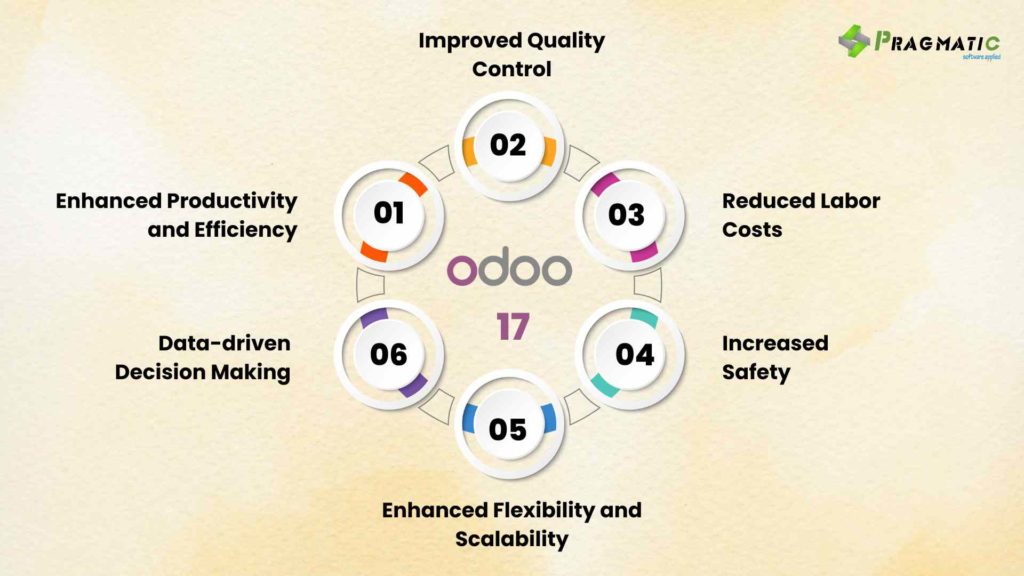

As competition intensifies and customer demands evolve rapidly, manufacturers are increasingly turning to automation to gain a strategic edge.
But what exactly are the real benefits of automating your manufacturing business with business automation solutions?
This blog delves into the power of Odoo 17 for manufacturing and explores how it can empower you to achieve operational excellence.
Imagine a production floor where robots handle repetitive tasks with precision, seamlessly integrated with an intelligent ERP system that optimizes inventory, tracks production in real-time and facilitates data-driven decision-making. This is the power of automation in manufacturing.
Here’s a glimpse into the key benefits :

1) Enhanced Productivity and Efficiency : Automation eliminates human error in repetitive tasks, allowing for faster production cycles and increased output.
2) Improved Quality Control : Manufacturing automation solutions like robotic arms and machine vision systems ensure consistent product quality by performing tasks with higher accuracy and repeatability. This translates to fewer defects and reduced waste.
3) Reduced Labor Costs : While automation may require an upfront investment, it can significantly reduce labor costs in the long run. Repetitive tasks can be automated, freeing up human resources to focus on higher-value activities like process improvement and innovation.
4) Increased Safety : Automating hazardous tasks like welding or heavy material handling minimizes the risk of workplace injuries and improves overall worker safety.
5) Enhanced Flexibility and Scalability : Automation solutions can adapt to production fluctuations and changing customer demands. Odoo 17’s modular design, for instance, allows you to easily scale functionalities like Manufacturing Resource Planning (MRP) or Inventory Management as your business grows.
6) Data-driven Decision Making : Modern automation solutions generate a wealth of real-time data on production processes, machine performance, and inventory levels. This data can be seamlessly integrated with an ERP system like Odoo 17, providing valuable insights for optimizing production planning, resource allocation, and overall business strategy.
Odoo 17 offers a comprehensive suite of functionalities specifically designed to meet the needs of modern manufacturers.
Here’s how Odoo 17 empowers businesses to leverage automation for success :
While the benefits of automation are clear, transitioning your manufacturing business can seem daunting.
Here’s a step-by-step guide to help you navigate the process with Odoo 17 :
1. Assess Your Needs
The first step is to conduct a thorough evaluation of your current manufacturing processes. Identify areas with bottlenecks, repetitive tasks and quality control challenges. Analyze your inventory management system and production planning procedures. This assessment will help you determine the specific functionalities of Odoo 17 that will provide the most significant impact.
2. Develop a Roadmap
Based on your needs assessment, develop a roadmap for implementing Odoo 17. This roadmap should define the specific modules you will utilize (e.g., MRP, Inventory Management, Quality Control), the level of customization required, and the timeline for implementation.
3. Partner with an Odoo Expert
Implementing Odoo 17 effectively requires expertise in both the software and manufacturing processes. Consider partnering with an experienced Odoo implementation partner like Pragmatic Techsoft. Our team can guide you through the entire process, from configuration to data migration and user training.
4. Data Migration and System Integration
Migrating existing data from your current system to Odoo 17 is a crucial step. Pragmatic Techsoft can ensure a smooth and accurate data migration process. Additionally, we can seamlessly integrate Odoo 17 with your existing manufacturing equipment or other business systems to create a unified and automated workflow.
5. User Training and Support
For successful adoption, comprehensive training for your team on Odoo 17 functionalities is essential. Pragmatic Techsoft offers customized training programs tailored to your specific needs and user roles. We also provide ongoing support to ensure your team can maximize the benefits of Odoo 17.
6. Continuous Improvement
Once Odoo 17 is implemented, monitor key performance indicators (KPIs) like production output, cycle times and inventory levels. Use the data generated by Odoo to identify areas for further improvement and refine your automation strategy.
Odoo 17’s open-source architecture allows for extensive customization and integration with third-party applications.
Here are some ways to leverage Odoo 17 for even more advanced automation :
By embracing these advanced automation techniques alongside Odoo 17, you can gain a significant competitive edge in the manufacturing landscape.
Automating your manufacturing business with Odoo 17 is a strategic investment that can deliver significant benefits.
Contact Pragmatic Techsoft today to discuss your specific needs and explore how Odoo 17 can help you streamline your manufacturing operations.
Stay tuned to our website and blogs for more insights on leveraging Odoo 17 to optimize your manufacturing business.
Leave a Reply
You must be logged in to post a comment.